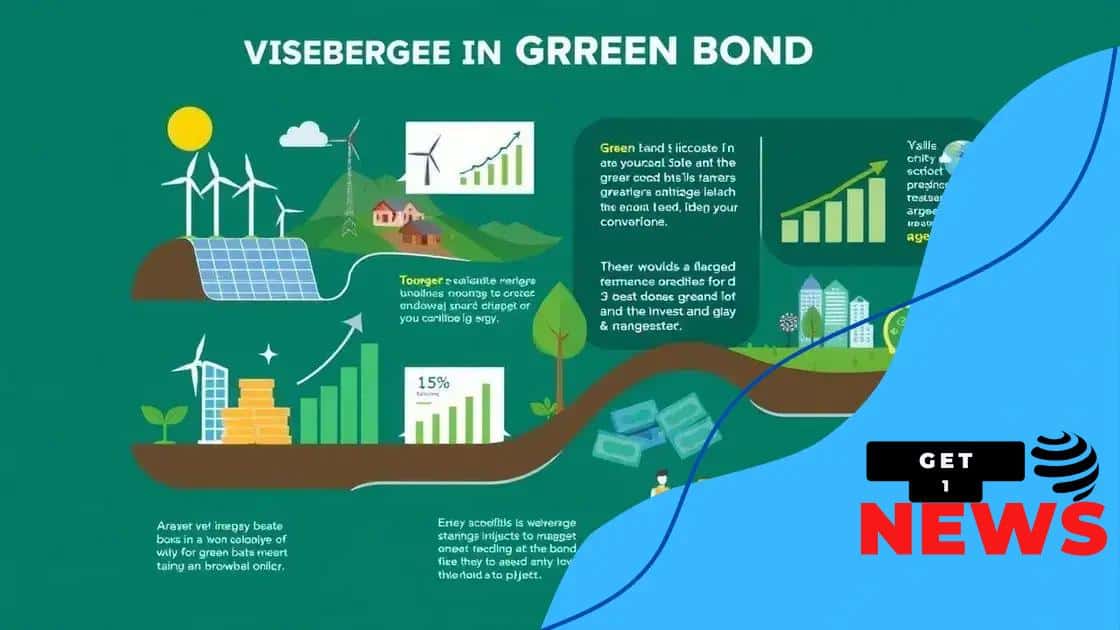Green bond market analysis: unlocking investment opportunities

The green bond market offers investment opportunities that finance environmentally friendly projects while providing competitive returns, but investors must be aware of associated risks such as credit and market volatility.
Green bond market analysis has become essential for investors looking to contribute to sustainability. As the demand for eco-friendly investments rises, understanding this market can help you navigate new opportunities.
Understanding the green bond market
Understanding the green bond market is crucial for anyone looking to invest in sustainable projects. This market has gained traction over the last decade, providing a new way for issuers to raise funds while promoting environmental initiatives. What makes green bonds attractive is that they are specifically geared towards financing projects that have positive environmental impacts.
Key characteristics of green bonds
Investors should know that green bonds have unique features that differentiate them from traditional bonds. For instance, they typically come with stringent reporting requirements to ensure that the funds raised are used for the intended environmental projects.
- Proceeds are exclusively used for green projects.
- Transparency and accountability in fund allocation.
- Regular reporting on the impact of projects funded.
- Similar returns to conventional bonds.
Additionally, the demand for green bonds is on the rise. More investors are considering environmental, social, and governance (ESG) factors when making investment decisions. This shift reflects a broader trend towards responsible investing and is pushing companies to explore opportunities within the green bond framework.
Market growth and trends
The growth of the green bond market has been remarkable. In recent years, significant advances have occurred, encouraging more issuers to tap into this funding source. As the market expands, investment opportunities are diversifying, with a variety of projects available for funding.
- Increased issuance from corporate and government sectors.
- Emerging markets gaining traction.
- Development of new green finance standards.
- Investment in renewable energy and sustainable infrastructure.
As a result of these trends, understanding the dynamics of the green bond market is essential. Investors should be aware of the risks and rewards associated with these bonds, including credit risk and project performance. Ultimately, informed decisions can lead to a profitable and sustainable investment portfolio.
Key players in green bond issuance
When exploring the key players in green bond issuance, it’s important to recognize the diverse groups involved in this market. These entities contribute to the growth and development of green bonds, making them essential to understanding how the market operates.
Government and public agencies
Government institutions play a vital role in the green bond market. They often issue bonds to finance projects focused on sustainability, and these bonds set standards for others to follow.
- Provide frameworks for green financing.
- Facilitate the issuance of green bonds for environmental projects.
- Support infrastructure and renewable energy initiatives.
- Encourage transparency among issuers.
Another significant player in this arena is the corporate sector. Many companies are increasingly seeing the benefits of green bonds. By issuing these bonds, businesses fund projects that not only align with their sustainability goals but also appeal to socially conscious investors.
Financial institutions and investors
Financial institutions such as banks and investment funds are also crucial participants. They help facilitate the issuance process and often act as underwriters for new green bonds. Their involvement provides credibility and encourages more issuers to enter this growing market.
- Underwrite bonds to ensure financial stability.
- Provide advisory services for potential issuers.
- Advocate for responsible investing.
- Support secondary market trading of green bonds.
Finally, numerous organizations and non-profits contribute to the green bond framework by establishing guidelines and certifications. These groups ensure that projects funded by green bonds meet environmental standards, giving investors greater confidence in their purchases. By engaging with these key players, stakeholders can further explore the opportunities within the green bond market, driving its growth.
Benefits of investing in green bonds

Investing in green bonds provides numerous advantages for both individual investors and the broader community. First and foremost, these bonds help finance environmentally friendly projects that contribute to a sustainable future.
Financial advantages
One significant benefit is the potential for competitive returns. While some might think green bonds yield lower returns, many are structured to provide comparable interest rates to traditional bonds. As the demand for sustainable investments increases, these bonds often attract more investors, further strengthening their market.
- Competitive interest rates comparable to traditional bonds.
- Possibility of receiving tax incentives in some regions.
- Strong demand leading to better liquidity.
- Diversification of investment portfolios.
Additionally, by investing in green bonds, individuals contribute to positive environmental change. They help fund projects like renewable energy, energy efficiency upgrades, and sustainable agriculture. Each investment supports clean technology and eco-friendly infrastructure.
Social impact and reputation
Beyond financial gains, green bonds enhance an investor’s reputation. They signal a commitment to sustainability and responsible investing, appealing to socially conscious consumers and attracting more clients. Many large organizations focus on environmental, social, and governance (ESG) criteria when selecting investments, emphasizing the growing importance of responsible business practices.
- Enhances reputation as a socially responsible investor.
- Aligns with personal values regarding sustainability.
- Encourages transparency and accountability in investments.
- Attracts a growing base of ESG-focused clients.
Ultimately, investing in green bonds is not just about generating financial returns; it’s about being part of a movement towards a more sustainable and responsible future. This dual benefit makes these instruments increasingly appealing in today’s market.
Risks associated with green bonds
While investing in green bonds offers many benefits, it is essential to understand the associated risks. Awareness of these risks can help investors make informed decisions and manage their portfolios effectively.
Credit risk
One prevalent risk is credit risk. This occurs when the issuer of the bond struggles to make timely interest payments or repay the principal amount. It’s crucial to research the issuer’s financial health and credit ratings before investing.
- Consider the issuer’s credit rating and track record.
- Assess the financial stability of the institutions involved.
- Look for history in completing similar projects.
- Understand industry-specific risks associated with the issuer.
Another risk is related to project performance. Not all green projects succeed; some may face delays or budget overruns. If a project funded by green bonds doesn’t meet its goals, the bond’s value could decline. It’s essential to monitor the project’s progress regularly.
Market risk
Market risk is also a factor to consider. Fluctuations in interest rates can impact bond prices. When interest rates rise, the value of existing bonds may fall, leading to potential losses for investors if they need to sell before maturity.
- Be aware of current economic conditions that may affect rates.
- Diversify your investment portfolio to minimize risks.
- Consider the overall demand for green bonds in the market.
- Analyze trends in interest rate movements.
Lastly, regulatory risk can affect green bonds. Changes in regulations or policies regarding environmental standards can impact the viability of projects. Staying updated on regulatory developments will help investors gauge potential risks.
In summary, understanding these risks—credit, project performance, market, and regulatory—is crucial for anyone considering green bonds. This awareness enables more strategic investment choices and better overall risk management.
Future trends in green bond investments
The future trends in green bond investments are shaping up to be exciting and full of potential. As more investors prioritize sustainability, the demand for green bonds is expected to rise significantly.
Increased issuance and diversity
One trend is the increased issuance of green bonds from various sectors. Companies in renewable energy, transportation, and infrastructure are exploring green bonds as a funding source. This diversity helps meet different environmental goals while attracting a broader range of investors.
- More industries participating in green bond issuance.
- Expanding opportunities for funding sustainable projects.
- Development of sector-specific green bonds.
- Increased participation from emerging markets.
Moreover, investors are looking for more transparency and impact reporting from issuers. As a result, many organizations are adopting rigorous frameworks and standards. This focus ensures that funds are used effectively, enhancing the credibility of green bonds in the market.
Integration with ESG factors
Another significant trend is the integration of Environmental, Social, and Governance (ESG) factors into investment decisions. Investors are increasingly considering how their choices affect social and environmental outcomes. This shift in mindset encourages issuers to align their projects with broader sustainability goals.
- Growing interest in sustainability-focused portfolios.
- More structured ESG evaluations of investment opportunities.
- Emergence of indexes focused on green securities.
- Enhanced engagement with stakeholders on sustainability issues.
Lastly, technological advancements are likely to influence the future of green bonds. Innovations such as blockchain can improve transparency and tracking of funds in real-time, making it easier for investors to verify the impact of their investments. These tools will help establish trust among investors and ensure accountability.
In summary, the future of green bond investments seems promising, with increased diversity, enhanced transparency, and a greater focus on sustainability shaping the market. Investors who keep an eye on these trends will be well-positioned to seize opportunities for profitable and responsible investment.
FAQ – Frequently Asked Questions about Green Bonds
What are green bonds?
Green bonds are fixed-income securities designed to raise funds for projects that have positive environmental impacts, such as renewable energy or sustainable infrastructure.
What are the benefits of investing in green bonds?
Investing in green bonds offers competitive returns, supports sustainability, and enhances the investor’s reputation as a socially responsible entity.
What risks should I consider before investing in green bonds?
Key risks include credit risk, market fluctuations, and the potential for project underperformance.
How do I stay informed about future trends in green bonds?
Monitoring industry reports, following regulatory changes, and staying updated on technological advancements are essential to understanding future trends in the green bond market.





